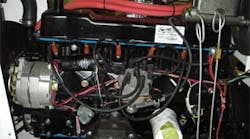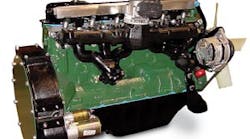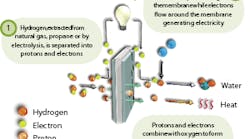New electric or electric conversions of GSE have helped minimize the ground support fleet’s contribution to carbon emissions at airports throughout the world. Hydrogen-fueled internal combustion engines offer one other less publicized way.
Technology for GSE developed by Canada’s Can-Am Modev, for example, had its beginnings in 2002, but wasn’t seriously considered until 2003. And it didn’t reach the in-service test stage until 2010, and those tests continue today at Montréal-Pierre Elliott Trudeau International Airport (YUL) on a fleet of hydrogen-powered tractors.
The company first paired its engine technology with another power source – fuel cells – before settling its energy on a hydrogen-fueled internal combustion engine. By 2004, the Canadian government considered for the first time to fund a study of three types of hydrogen-powered ground vehicles for the so-called “H2Port” project:
- baggage tractors,
- transit buses,
- and taxi cabs.
For a few years, the project spent more time derailed than on track, before contracts for a number of baggage tractors were finally issued in 2009. The other two ground vehicles failed to make the cut.
The reputation for dependability and safety in aviation-related equipment comes from data-driven designs. No airline or ground operation would consider equipment unless it had been proven in testing or by use in a similar application elsewhere. Recognizing this, the Canadian government funded the test case at YUL. Air Canada continues to run the test.
The plan was for these tractors to gather usage data for fuel consumption, fueling cycle, maintenance, utility, ease of use, and other items. This data may give airlines and baggage handling operations a clearer picture of this alternative technology.
Currently, three baggage tractors have been converted to use hydrogen at YUL. Operating data continues to be collected and the results will eventually be shared with airlines and baggage handling companies. Approval from the Canadian Ministry of Transport is the next step.
One unexpected benefit, however, is already apparent. Internal combustion engine-powered tractors are not permitted inside the airport terminal building due to emissions.
Currently, such tractors are unhooked and electric-powered tractors are connected to complete the transfer of baggage from the ramp to the baggage conveyor. The time required to move baggage between aircraft and conveyor is obviously increased.
Since hydrogen-fueled tractors emit only water vapor, they can proceed directly to the conveyor from the ramp. It is estimated each test tractor saves 1.3 hours per day in unnecessary hooking/unhooking.
THE CONVERSION PROCESS
Since hydrogen is less dense than other fuels, storing it takes up more room and special provisions had to be made for on-vehicle storage. Can-Am Modev selected two Dynetek high-pressure vessels, locating them behind the seats and in front of the hitch pin. Fuel piping and delivery to the engine had to be designed for the new fuel, but the company adapted fuel injection control schemes used for gasoline engines. There were other differences, such as injectors and sensors.
Other than the new fuel system for the tractor, the company says the conversion is very similar to an engine replacement for a worn-out engine. The engine bolts directly to most tractor transmissions with no adaptations, since, in most cases, the block is the same as what came from the tractor manufacturer. The “gas” pedal is electronic rather than mechanical, just as in many cars today. The engine controller mounts to the firewall or inside fender, depending on the tractor manufacturer.
The company says finding a zero-NOx operating point and staying there under variable loads and speeds took a fair amount of work. The engines themselves were higher compression than for unleaded gasoline, but nothing that required new science.
Below are the undesirable emissions curves for gasoline and hydrogen, as well as the target operating points for both engines. Those operating points are the minimal emissions points. Note that hydrogen is usable as a fule at a much lower Phi (fuel-air percentage). Electronic engine control is essential to maintaining operation at those points as load and speed change.
Fuel cells require laboratory grade fuel. Hydrogen internal combustion engine systems, on the other hand, will operate with industrial grade.
Impurities in the fuel may contribute to emissions increases, but a few percents of impurities will not affect performance. A central fueling point at the airport and/or rolling tankers are the expected fuel resupply scenarios. YUL has a central fueling station. Refueling takes only a few minutes.
HYDROGEN’S COST
Hydrogen is available from a number of industrial gas companies in North America. However, green sources of energy such as wind, solar or at least off-peak traditional electrical power can produce hydrogen via electrolysis.
The cost of hydrogen varies, depending on its source. The current retail price of hydrogen ranges from $8 to $16 per kilogram, but that is at small volumes. That price is expected to decrease with increasing volume. U.S. gasoline production, for example, is at a scale of several hundreds of millions of gallons per day, while U.S. hydrogen production is less than 125 metric tons per day
It’s difficult to make direct cost comparisons between the two. A hydrogen engine is 10 percent to 20 more efficient than a gasoline engine. Gasoline engines on the ramp are also frequently left idling because restarting them is sometimes a challenge whereas hydrogen engines have near-instant starting capacities – even in very cold weather.
The difference in how to precisely measure the fuels makes comparison difficult. Gasoline, of course, is measured in gallons or liters. Meanwhile, hydrogen is measured in standard cubic feet – the volume at sea level pressure, or in kilograms.
To create an apples-to-apples comparison, a new measure has been developed, based upon the energy content of each fuel. One kilogram of hydrogen is approximately one “gasoline gallon equivalent” in energy content.
The elimination of emissions and ease of conversion remain the primary benefits initially, with declining operating costs later as the price of hydrogen comes down. Gasoline and diesel costs, on the other hand, can be expected to continue to rise.
Can-Am Modev expects more tests on larger numbers of tractors and perhaps other equipment in the future. Toronto’s Pearson Airport (YYZ) and Vancouver International Airport (YVR) have been mentioned as probable next sites for testing, as well as increasing the number of test tractors converted at YUL. Several U.S. airports have also shown interest, but await the test results. Not every tractor is a good fit for the hydrogen engine, the company says, but the majority would work with it.








